Assessing Nature-Based Recreation to Support Urban Green Infrastructure Planning in Trento (Italy)
Abstract
:1. Introduction
2. Materials and Methods
2.1. Introducing the Case Study
2.2. Adapting the ESTIMAP-Recreation Model to the Local Context
- The first section assesses the Recreation Potential (RP), i.e., the capacity of green infrastructure to support nature-based recreational activities based on their intrinsic characteristics, independently from their actual or potential use. The components included in the original version are water, natural protected areas, and degree of naturalness. The RP is described by a raster map with relative values ranging from 0 (no recreation potential) to 1 (maximum recreation potential in the analyzed area).
- The second section assesses the Recreation Opportunity Spectrum (ROS) by combining the RP with information about proximity (i.e., in the original version, distance from roads and urban areas), thus providing an assessment of the opportunities for recreational activities offered to the citizens. The ROS is described by a raster map classified into nine categories resulting from the cross-tabulation of high/medium/low values of RP and high/medium/low values of proximity.
- The third section includes an assessment of the use or demand for recreation obtained from an analysis of the spatial distribution of potential users and corresponding levels of accessibility.
2.3. Assessing Nature-Based Recreation in Trento
3. Results
3.1. Recreation Potential (RP) and Recreation Opportunity Spectrum (ROS) in the City of Trento
3.2. A Comparison of Indicators for Urban Planning
4. Discussion
4.1. Nature-Based Recreation from an Ecosystem Service Perspective
4.2. How the Assessment of Nature-Based Recreation Can Support Urban Planning
4.3. Limitations of the Study
4.4. Remarks from the Application Process in the Case Study
5. Conclusions
Author Contributions
Funding
Acknowledgments
Conflicts of Interest
References
- Haines-Young, R.; Potschin-Young, M. Common International Classification of Ecosystem Services (CICES) V5.1 and Guidance on the Application of the Revised Structure. 2018. Available online: https://cices.eu/ (accessed on 31 July 2018).
- Gómez-Baggethun, E.; Barton, D.N. Classifying and valuing ecosystem services for urban planning. Ecol. Econ. 2013, 86, 235–245. [Google Scholar] [CrossRef]
- Elmqvist, T.; Gómez-Baggethun, E.; Langemeyer, J. Ecosystem Services provided by urban green infrastructure. In Routledge Handbook of Ecosystem Services; Potschin, M., Haines-Young, R., Fish, R., Turner, R.K., Eds.; Routledge: New York, NY, USA, 2016; pp. 452–464. [Google Scholar]
- Bratman, G.N.; Hamilton, J.P.; Hahn, K.S.; Daily, G.C.; Gross, J.J. Nature experience reduces rumination and subgenual prefrontal cortex activation. Proc. Natl. Acad. Sci. USA 2015, 112, 8567–8572. [Google Scholar] [CrossRef] [PubMed]
- Park, B.J.; Tsunetsugu, Y.; Kasetani, T.; Hirano, H.; Kagawa, T.; Sato, M.; Miyazaki, Y. Physiological effects of Shinrin-yoku (taking in the atmosphere of the forest)-using salivary cortisol and cerebral activity as indicators. J. Physiol. Anthropol. 2007, 26, 123–128. [Google Scholar] [CrossRef] [PubMed]
- Bowler, D.E.; Buyung-Ali, L.M.; Knight, T.M.; Pullin, A.S. A systematic review of evidence for the added benefits to health of exposure to natural environments. BMC Public Health 2010, 10, 456. [Google Scholar] [CrossRef] [PubMed]
- Barton, J.; Pretty, J. What is the best dose of nature and green exercise for improving mental health? A multi-study analysis. Environ. Sci. Technol. 2010, 44, 3947–3955. [Google Scholar] [CrossRef] [PubMed]
- Bratman, G.N.; Daily, G.C.; Levy, B.J.; Gross, J.J. The benefits of nature experience: Improved affect and cognition. Landsc. Urban Plan. 2015, 138, 41–50. [Google Scholar] [CrossRef]
- Faber Taylor, A.; Kuo, F.E. Children with Attention Deficits Concentrate Better After Walk in the Park. J. Atten. Disord. 2008, 12, 402–409. [Google Scholar] [CrossRef] [PubMed]
- Dadvand, P.; Nieuwenhuijsen, M.J.; Esnaola, M.; Forns, J.; Basagaña, X.; Alvarez-Pedrerol, M.; Rivas, I.; López-Vicente, M.; Pascual, M.D.; Su, J.; et al. Green spaces and cognitive development in primary schoolchildren. Proc. Natl. Acad. Sci. USA 2015, 112, 7937–7942. [Google Scholar] [CrossRef] [PubMed] [Green Version]
- Kaczynski, A.T.; Henderson, K.A. Environmental Correlates of Physical Activity: A Review of Evidence about Parks and Recreation. Leis. Sci. 2007, 29, 315–354. [Google Scholar] [CrossRef]
- Floyd, M.F.; Bocarro, J.N.; Smith, W.R.; Baran, P.K.; Moore, R.C.; Cosco, N.G.; Edwards, M.B.; Suau, L.J.; Fang, K. Park-based physical activity among children and adolescents. Am. J. Prev. Med. 2011, 41, 258–265. [Google Scholar] [CrossRef] [PubMed]
- Kingsley, J.Y.; Townsend, M. ‘Dig In’ to Social Capital: Community Gardens as Mechanisms for Growing Urban Social Connectedness. Urban Policy Res. 2006, 24, 525–537. [Google Scholar] [CrossRef]
- Westphal, L.M. Urban greening and social benefits: A study of empowerment outcomes. J. Arboric. 2003, 29, 137–147. [Google Scholar]
- Shinew, K.J.; Glover, T.D.; Parry, D.C. Leisure spaces as potential sites for interracial interactions: Community gardens in urban areas. J. Leis. Res. 2004, 36, 336–355. [Google Scholar] [CrossRef]
- Chiesura, A. The role of urban parks for the sustainable city. Landsc. Urban Plan. 2004, 68, 129–138. [Google Scholar] [CrossRef]
- Bertram, C.; Larondelle, N. Going to the woods is going home: Recreational benefits of a larger urban forest site—A travel cost analysis for Berlin, Germany. Ecol. Econ. 2016, 132, 255–263. [Google Scholar] [CrossRef]
- Takano, T.; Nakamura, K.; Watanabe, M. Urban residential environments and senior citizens’ longevity in megacity areas: The importance of walkable green spaces. J. Epidemiol. Community Health 2002, 56, 913–918. [Google Scholar] [CrossRef] [PubMed]
- Zasada, I. Multifunctional peri-urban agriculture—A review of societal demands and the provision of goods and services by farming. Land Use Policy 2011, 28, 639–648. [Google Scholar] [CrossRef]
- Pueffel, C.; Haase, D.; Priess, J.A. Mapping ecosystem services on brownfields in Leipzig, Germany. Ecosyst. Serv. 2018, 30, 73–85. [Google Scholar] [CrossRef]
- Foster, J. Hiding in plain view: Vacancy and prospect in Paris’ Petite Ceinture. Cities 2014, 40, 124–132. [Google Scholar] [CrossRef]
- Caspersen, O.H.; Olafsson, A.S. Recreational mapping and planning for enlargement of the green structure in greater Copenhagen. Urban For. Urban Green. 2010, 9, 101–112. [Google Scholar] [CrossRef]
- Kienast, F.; Degenhardt, B.; Weilenmann, B.; Wäger, Y.; Buchecker, M. GIS-assisted mapping of landscape suitability for nearby recreation. Landsc. Urban Plan. 2012, 105, 385–399. [Google Scholar] [CrossRef]
- Sasidharan, V.; And, F.W.; Godbey, G. Cultural differences in urban recreation patterns: An examination of park usage and activity participation across six population subgroups. Manag. Leis. 2005, 10, 19–38. [Google Scholar] [CrossRef]
- Cortinovis, C.; Geneletti, D. Ecosystem services in urban plans: What is there and what is still needed for better decisions. Land Use Policy 2018, 70, 298–312. [Google Scholar] [CrossRef]
- Wilkinson, C.; Saarne, T.; Peterson, G.D.; Colding, J. Strategic spatial planning and the ecosystem services concept—An historical exploration. Ecol. Soc. 2013, 18, 37. [Google Scholar] [CrossRef]
- Rall, E.L.; Kabisch, N.; Hansen, R. A comparative exploration of uptake and potential application of ecosystem services in urban planning. Ecosyst. Serv. 2015, 16, 230–242. [Google Scholar] [CrossRef]
- Kabisch, N.; Haase, D. Green justice or just green? Provision of urban green spaces in Berlin, Germany. Landsc. Urban Plan. 2014, 122, 129–139. [Google Scholar] [CrossRef]
- Badiu, D.L.; Iojă, C.I.; Pătroescu, M.; Breuste, J.; Artmann, M.; Niță, M.R.; Grădinaru, S.R.; Hossua, C.A.; Onosea, D.A. Is urban green space per capita a valuable target to achieve cities’ sustainability goals? Romania as a case study. Ecol. Indic. 2016, 70, 53–66. [Google Scholar] [CrossRef]
- Kabisch, N.; Strohbach, M.W.; Haase, D.; Kronenberg, J. Urban green space availability in European cities. Ecol. Indic. 2016, 70, 586–596. [Google Scholar] [CrossRef]
- Fuller, R.A.; Gaston, K.J. The scaling of green space coverage in European cities. Biol. Lett. 2009, 5, 352–355. [Google Scholar] [CrossRef] [PubMed] [Green Version]
- Ortiz, M.S.O.; Geneletti, D. Assessing Mismatches in the Provision of Urban Ecosystem Services to Support Spatial Planning: A Case Study on Recreation and Food Supply in Havana, Cuba. Sustainability 2018, 10, 2165. [Google Scholar] [CrossRef]
- Wolch, J.R.; Byrne, J.; Newell, J.P. Urban green space, public health, and environmental justice: The challenge of making cities ‘just green enough’. Landsc. Urban Plan. 2014, 125, 234–244. [Google Scholar] [CrossRef] [Green Version]
- La Rosa, D. Accessibility to greenspaces: GIS based indicators for sustainable planning in a dense urban context. Ecol. Indic. 2014, 42, 122–134. [Google Scholar] [CrossRef]
- Stessens, P.; Khan, A.Z.; Huysmans, M.; Canters, F. Analysing urban green space accessibility and quality: A GIS-based model as spatial decision support for urban ecosystem services in Brussels. Ecosyst. Serv. 2017, 28, 328–340. [Google Scholar] [CrossRef]
- Paracchini, M.L.; Zulian, G.; Kopperoinen, L.; Maes, J.; Schägner, J.P.; Termansen, M.; Zandersen, M.; Perez-Soba, M.; Scholefield, P.A.; Bidoglio, G. Mapping cultural ecosystem services: A framework to assess the potential for outdoor recreation across the EU. Ecol. Indic. 2014, 45, 371–385. [Google Scholar] [CrossRef] [Green Version]
- Schirpke, U.; Meisch, C.; Marsoner, T.; Tappeiner, U. Revealing spatial and temporal patterns of outdoor recreation in the European Alps and their surroundings. Ecosyst. Serv. 2018, 31, 336–350. [Google Scholar] [CrossRef]
- Ala-Hulkko, T.; Kotavaara, O.; Alahuhta, J.; Helle, P.; Hjort, J. Introducing accessibility analysis in mapping cultural ecosystem services. Ecol. Indic. 2016, 66, 416–427. [Google Scholar] [CrossRef]
- Baró, F.; Palomo, I.; Zulian, G.; Vizcaino, P.; Haase, D.; Gómez-Baggethungh, E. Mapping ecosystem service capacity, flow and demand for landscape and urban planning: A case study in the Barcelona metropolitan region. Land Use Policy 2016, 57, 405–417. [Google Scholar] [CrossRef]
- Rall, E.L.; Bieling, C.; Zytynska, S.; Haase, D. Exploring city-wide patterns of cultural ecosystem service perceptions and use. Ecol. Indic. 2017, 77, 80–95. [Google Scholar] [CrossRef]
- Niemelä, J.; Saarela, S.R.; Söderman, T.; Kopperoinen, L.; Yli-Pelkonen, V.; Väre, S.; Kotze, D.J. Using the ecosystem services approach for better planning and conservation of urban green spaces: A Finland case study. Biodivers. Conserv. 2010, 19, 3225–3243. [Google Scholar] [CrossRef]
- Hegetschweiler, K.T.; de Vries, S.; Arnberger, A.; Bell, S.; Brennan, M.; Siter, N.; Olafsson, A.S.; Voigt, A.; Hunziker, M. Linking demand and supply factors in identifying cultural ecosystem services of urban green infrastructures: A review of European studies. Urban For. Urban Green. 2017, 21, 48–59. [Google Scholar] [CrossRef] [Green Version]
- Kulczyk, S.; Woźniak, E.; Derek, M. Landscape, facilities and visitors: An integrated model of recreational ecosystem services. Ecosyst. Serv. 2018, 31, 491–501. [Google Scholar] [CrossRef]
- Zulian, G.; Stange, E.; Woods, H.; Carvalho, L.; Dick, J.; Andrews, C.; Baró, F.; Vizcain, P.; Barton, D.N.; Rusch, G.M.; et al. Practical application of spatial ecosystem service models to aid decision support. Ecosyst. Serv. 2018, 29, 465–480. [Google Scholar] [CrossRef] [PubMed]
- Comune Di Trento. Carta Di Uso Del Suolo/Land Use Map. 2017. Available online: http://www.comune.trento.it/Aree-tematiche/Cartografia/Download/Carta-uso-del-suolo-Open-Data2 (accessed on 1 September 2017).
- Zulian, G.; Paracchini, M.L.; Maes, J.; Liquete Garcia, M.D.C. ESTIMAP: Ecosystem Services Mapping at European Scale; Publications Office of the European Union: Luxembourg, 2013. [Google Scholar]
- Vallecillo, S.; La Notte, A.; Polce, C.; Zulian, G.; Maes, J.; Alexandris, N.; Ferrini, S. Ecosystem Services Accounting: Part. I—Outdoor Recreation and Crop Pollination; Publications Office of the European Union: Luxembourg, 2018. [Google Scholar]
- Liquete, C.; Piroddi, C.; Macías, D.; Druon, J.-N.; Zulian, G. Ecosystem services sustainability in the Mediterranean Sea: Assessment of status and trends using multiple modelling approaches. Sci. Rep. 2016, 6, 34162. [Google Scholar] [CrossRef] [PubMed]
- La Notte, A.; Vallecillo, S.; Polce, C.; Zulian, G.; Maes, J. Implementing an EU System of Accounting for Ecosystems and Their Services. Initial Proposals for the Implementation of Ecosystem Services Accounts; Publications Office of the European Union: Luxembourg, 2017. [Google Scholar]
- Maes, J.; Teller, A.; Erhard, M.; Liquete, C.; Braat, L.; Berry, P.; Lavalle, C.; Egoh, B.; Kristensen, P.; Paracchini, M.L.; et al. Mapping and Assessment of Ecosystems and Their Services: Trends in Ecosystems and Ecosystem Services in the European Union between 2000 and 2010; Publications Office of the European Union: Luxembourg, 2015. [Google Scholar]
- Cortinovis, C.; Geneletti, D. Mapping and assessing ecosystem services to support urban planning: A case study on brownfield regeneration. One Ecosyst. 2018, 3, e25477. [Google Scholar] [CrossRef]
- Zulian, G.; Thijssen, M.; Maes, J. Enhancing Resilience of Urban Ecosystems through Green Infrastructure (EnRoute) Progress Report; Publication Office of the European Union: Luxembourg, 2018. [Google Scholar]
- Open Street Map Contributors. 2017. Available online: https://www.openstreetmap.org (accessed on 1 September 2017).
- World Health Organization. Urban Green Spaces and Health: A Review of Evidence; WHO Regional Office for Europe: Copenhagen, Denmark, 2016; Available online: http://www.euro.who.int/__data/assets/pdf_file/0005/321971/Urban-green-spaces-and-health-review-evidence.pdf?ua=1 (accessed on 31 July 2018).
- Boscoe, F.P.; Henry, K.A.; Zdeb, M.S. A Nationwide Comparison of Driving Distance Versus Straight-Line Distance to Hospitals. Prof. Geogr. 2012, 64, 188–196. [Google Scholar] [CrossRef] [PubMed] [Green Version]
- Provincia Autonoma di Trento. Piano Urbanistico Provinciale/Urban Plan of the Autonomous Province of Trento. 2017. Available online: http://www.urbanistica.provincia.tn.it/pianificazione/piano_urbanistico_provinciale/cartografia/pagina147.html (accessed on 1 September 2017).
- Provincia Autonoma di Trento. Piano Generale di Utilizzazione delle Acque Pubbliche/General Plan of Public Water Uses. 2006. Available online: http://pguap.provincia.tn.it/ (accessed on 1 September 2017).
- Lando, M.; Gadotti, A. Alberi Maestri Nella Città E Nel Territorio di Trento; Comune di Trento, MUSE: Trento, Italy, 2016; Available online: http://www.comune.trento.it/Comunicazione/Il-Comune-informa/Ultime-notizie/Alberi-maestri-anno-2017 (accessed on 31 July 2018).
- Comune di Trento. Cartografia Verde e Mobilità Sostenibile/Database of Public Green Areas and Sustainable Mobility. 2010. Available online: http://webapps.comune.trento.it/mapaccel/?project=generale&view=verde&locale=it (accessed on 1 September 2017).
- Provincia Autonoma di Trento. Viabilità forestale/Map of Forest Tracks-2nd Edition. 2013. Available online: http://www.territorio.provincia.tn.it/portal/server.pt/community/sgc_-_geocatalogo/862/sgc_-_geocatalogo/32157 (accessed on 1 September 2017).
- Comune di Trento. Stradario del Comune di Trento/Street Map of Trento. 2017. Available online: http://www.comune.trento.it/Aree-tematiche/Cartografia/Download/Stradario-Open-Data2 (accessed on 1 September 2017).
- Provincia Autonoma di Trento. Piste ciclabili/Map of Cycle Paths-2nd Edition. 2010. Available online: http://www.territorio.provincia.tn.it/portal/server.pt/community/sgc_-_geocatalogo/862/sgc_-_geocatalogo/32157 (accessed on 1 September 2017).
- Società Alpinisti Tridentini. I Sentieri SAT del Trentino/SAT Hiking Trails in Trentino. 2017. Available online: https://trentino.webmapp.it/#/?map=12/46.0614/11.1326 (accessed on 1 September 2017).
- Camps-Calvet, M.; Langemeyer, J.; Calvet-Mir, L.; Gómez-Baggethun, E. Ecosystem services provided by urban gardens in Barcelona, Spain: Insights for policy and planning. Environ. Sci. Policy 2015, 62, 14–23. [Google Scholar] [CrossRef]
- Sanon, S.; Hein, T.; Douven, W.; Winkler, P. Quantifying ecosystem service trade-offs: The case of an urban floodplain in Vienna, Austria. J. Environ. Manag. 2012, 111, 159–172. [Google Scholar] [CrossRef] [PubMed]
- Casado-Arzuaga, I.; Onaindia, M.; Madariaga, I.; Verburg, P.H. Mapping recreation and aesthetic value of ecosystems in the Bilbao Metropolitan Greenbelt (northern Spain) to support landscape planning. Landsc. Ecol. 2013, 29, 1393–1405. [Google Scholar] [CrossRef]
- Gundersen, V.S.; Tangeland, T.; Kaltenborn, B.P. Planning for recreation along the opportunity spectrum: The case of Oslo, Norway. Urban For. Urban Green. 2015, 14, 210–217. [Google Scholar] [CrossRef]
- Wolff, S.; Schulp, C.J.E.; Verburg, P.H. Mapping ecosystem services demand: A review of current research and future perspectives. Ecol. Indic. 2015, 55, 159–171. [Google Scholar] [CrossRef]
- Voigt, A.; Kabisch, N.; Wurster, D.; Haase, D.; Breuste, J. Structural diversity: A multi-Dimensional approach to assess recreational services in urban parks. Ambio 2014, 43, 480–491. [Google Scholar] [CrossRef] [PubMed]
- Boll, T.; von Haaren, C.; von Ruschkowski, E. The Preference and Actual Use of Different Types of Rural Recreation Areas by Urban Dwellers—The Hamburg Case Study. PLoS ONE 2014, 9, e108638. [Google Scholar] [CrossRef] [PubMed] [Green Version]
- Hamstead, Z.A.; Fisher, D.; Ilieva, R.T.; Wood, S.A.; McPhearson, T.; Kremer, P. Geolocated social media as a rapid indicator of park visitation and equitable park access. Comput. Environ. Urban Syst. 2018, 72, 38–50. [Google Scholar] [CrossRef]
- Donahue, M.L.; Keeler, B.L.; Wood, S.A.; Fisher, D.M.; Hamstead, Z.A.; McPhearson, T. Using social media to understand drivers of urban park visitation in the Twin Cities, MN. Landsc. Urban Plan. 2018, 175, 1–10. [Google Scholar] [CrossRef]
- Balzan, M.; Debono, I. Assessing urban recreation ecosystem services through the use of geocache visitation and preference data: A case-study from an urbanised island environment. OneEcosystem 2018, 3, e24490. [Google Scholar] [CrossRef]
- La Rosa, D.; Spyra, M.; Inostroza, L. Indicators of Cultural Ecosystem Services for urban planning: A review. Ecol. Indic. 2015, 61, 74–89. [Google Scholar] [CrossRef]
- Albert, C.; Galler, C.; Hermes, J.; Neuendorf, F.; Von Haaren, C.; Lovett, A. Applying ecosystem services indicators in landscape planning and management: The ES-in-Planning framework. Ecol. Indic. 2015, 61, 100–113. [Google Scholar] [CrossRef]
- Baró, F.; Gómez-Baggethun, E.; Haase, D. Ecosystem service bundles along the urban-rural gradient: Insights for landscape planning and management. Ecosyst. Serv. 2017, 24, 147–159. [Google Scholar] [CrossRef]
- Panno, A.; Carrus, G.; Lafortezza, R.; Mariani, L.; Sanesi, G. Nature-based solutions to promote human resilience and wellbeing in cities during increasingly hot summers. Environ. Res. 2017, 159, 249–256. [Google Scholar] [CrossRef] [PubMed]
- Schirpke, U.; Scolozzi, R.; Da Re, R.; Masiero, M.; Pellegrino, D.; Marino, D. Recreational ecosystem services in protected areas: A survey of visitors to Natura 2000 sites in Italy. J. Outdoor Recreat. Tour. 2018, 21, 39–50. [Google Scholar] [CrossRef]
- Hansen, R.; Pauleit, S. From multifunctionality to multiple ecosystem services? A conceptual framework for multifunctionality in green infrastructure planning for Urban Areas. Ambio 2014, 43, 516–529. [Google Scholar] [CrossRef] [PubMed]
- McCormack, G.R.; Rock, M.; Toohey, A.M.; Hignell, D. Characteristics of urban parks associated with park use and physical activity: A review of qualitative research. Health Place 2010, 16, 712–726. [Google Scholar] [CrossRef] [PubMed]
- Eigenbrod, F.; Armsworth, P.R.; Anderson, B.J.; Heinemeyer, A.; Gillings, S.; Roy, D.B.; Thomas, C.D.; Gaston, K.J. The impact of proxy-based methods on mapping the distribution of ecosystem services. J. Appl. Ecol. 2010, 47, 377–385. [Google Scholar] [CrossRef] [Green Version]
- Gonçalves, D.N.S.; Gonçalves, C.D.M.; Assis, T.F.; De Silva, M.A. Analysis of the difference between the euclidean distance and the actual road distance in Brazil. Transp. Res. Procedia 2014, 3, 876–885. [Google Scholar] [CrossRef]
- Carling, K.; Han, M.; Håkansson, J. Does Euclidean distance work well when the p-median model is applied in rural areas? Ann. Oper. Res. 2012, 201, 83–97. [Google Scholar] [CrossRef]
- Massoni, E.S.; Barton, D.N.; Rusch, G.M.; Gundersen, V. Bigger, more diverse and better? Mapping structural diversity and its recreational value in urban green spaces. Ecosyst. Serv. 2018, 31, 502–516. [Google Scholar] [CrossRef]
- Edwards, D.; Jay, M.; Jensen, F.S.; Lucas, B.; Marzano, M.; Montagné, C.; Weiss, G.; Marzano, M. Public preferences for structural attributes of forests: Towards a pan-European perspective. For. Policy Econ. 2012, 19, 12–19. [Google Scholar] [CrossRef]
- Gundersen, V.S.; Frivold, L.H. Public preferences for forest structures: A review of quantitative surveys from Finland, Norway and Sweden. Urban For. Urban Green. 2008, 7, 241–258. [Google Scholar] [CrossRef]
- Saarela, S.-R.; Rinne, J. Knowledge brokering and boundary work for ecosystem service indicators. An urban case study in Finland. Ecol. Indic. 2015, 61, 49–62. [Google Scholar] [CrossRef]
- Palacios-Agundez, I.; Peña, L.; Ametzaga-Arregi, I.; Rodríguez-Loinaz, G.; Onaindia, M. Sustainable landscape management based on cultural ecosystem services. Chang. Adapt. Soc.-Ecol. Syst. 2017, 3, 103–110. [Google Scholar] [CrossRef] [Green Version]
- Turnhout, E. The effectiveness of boundary objects: The case of ecological indicators. Sci. Public Policy 2009, 36, 403–412. [Google Scholar] [CrossRef]
- Sébastien, L.; Bauler, T.; Lehtonen, M. Can Indicators Bridge the Gap between Science and Policy? An Exploration into the (Non)Use and (Non)Influence of Indicators in EU and UK Policy Making. Nat. Cult. 2014, 9, 316–343. [Google Scholar] [CrossRef] [Green Version]
- Andersson, E.; Tengö, M.; McPhearson, T.; Kremer, P. Cultural ecosystem services as a gateway for improving urban sustainability. Ecosyst. Serv. 2015, 12, 165–168. [Google Scholar] [CrossRef]
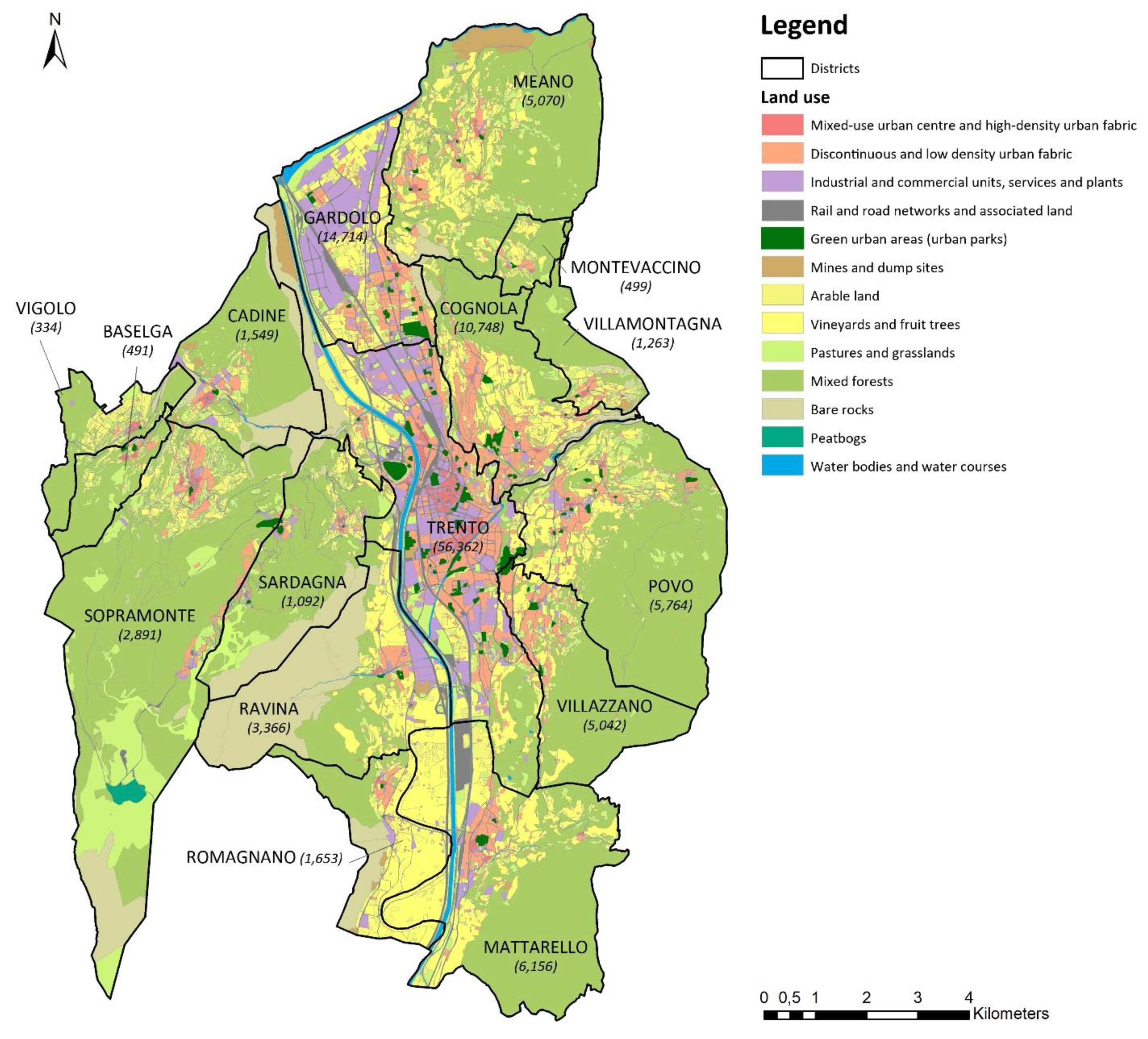
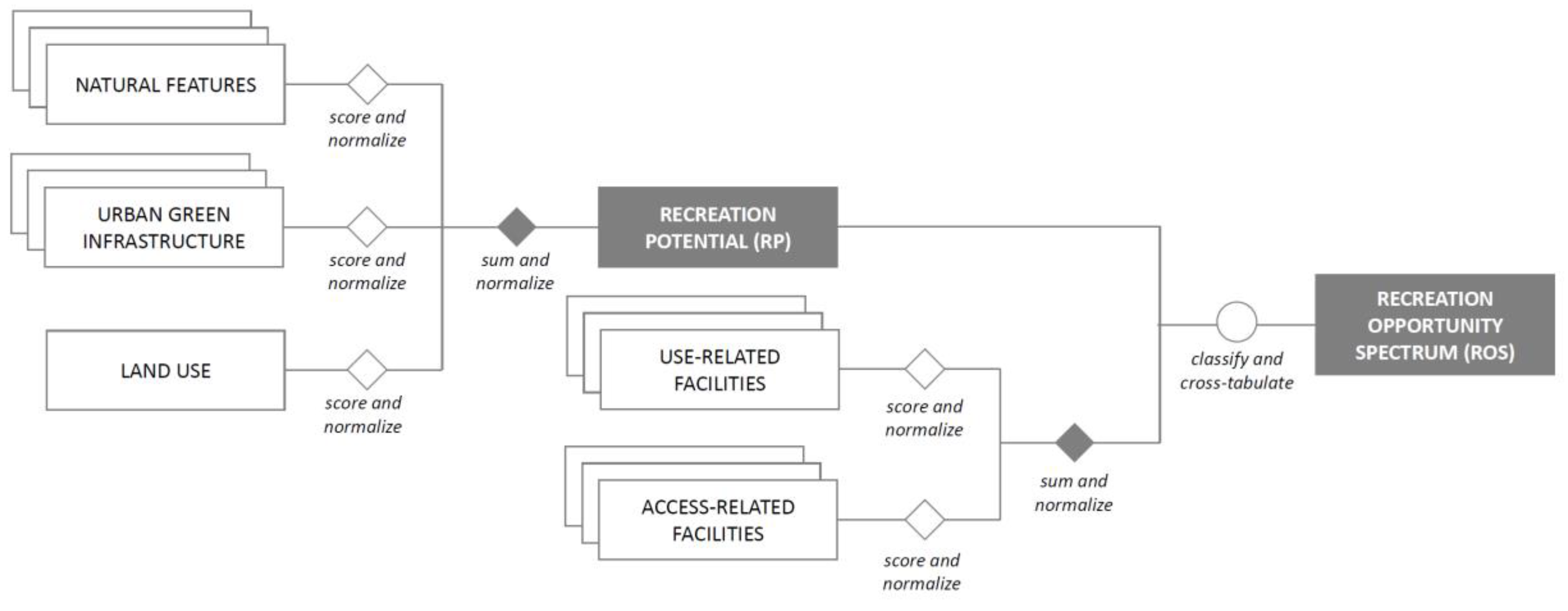
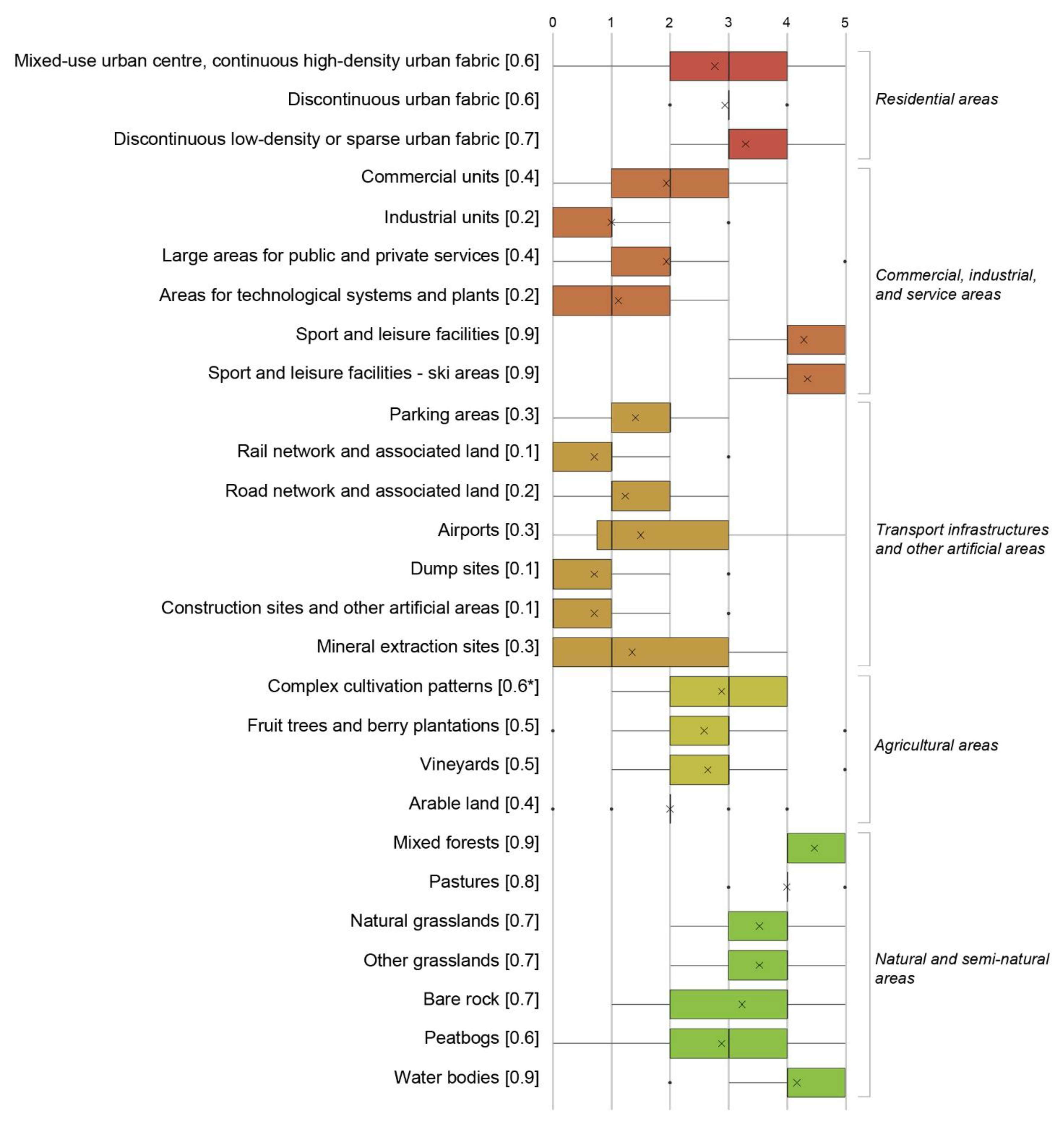
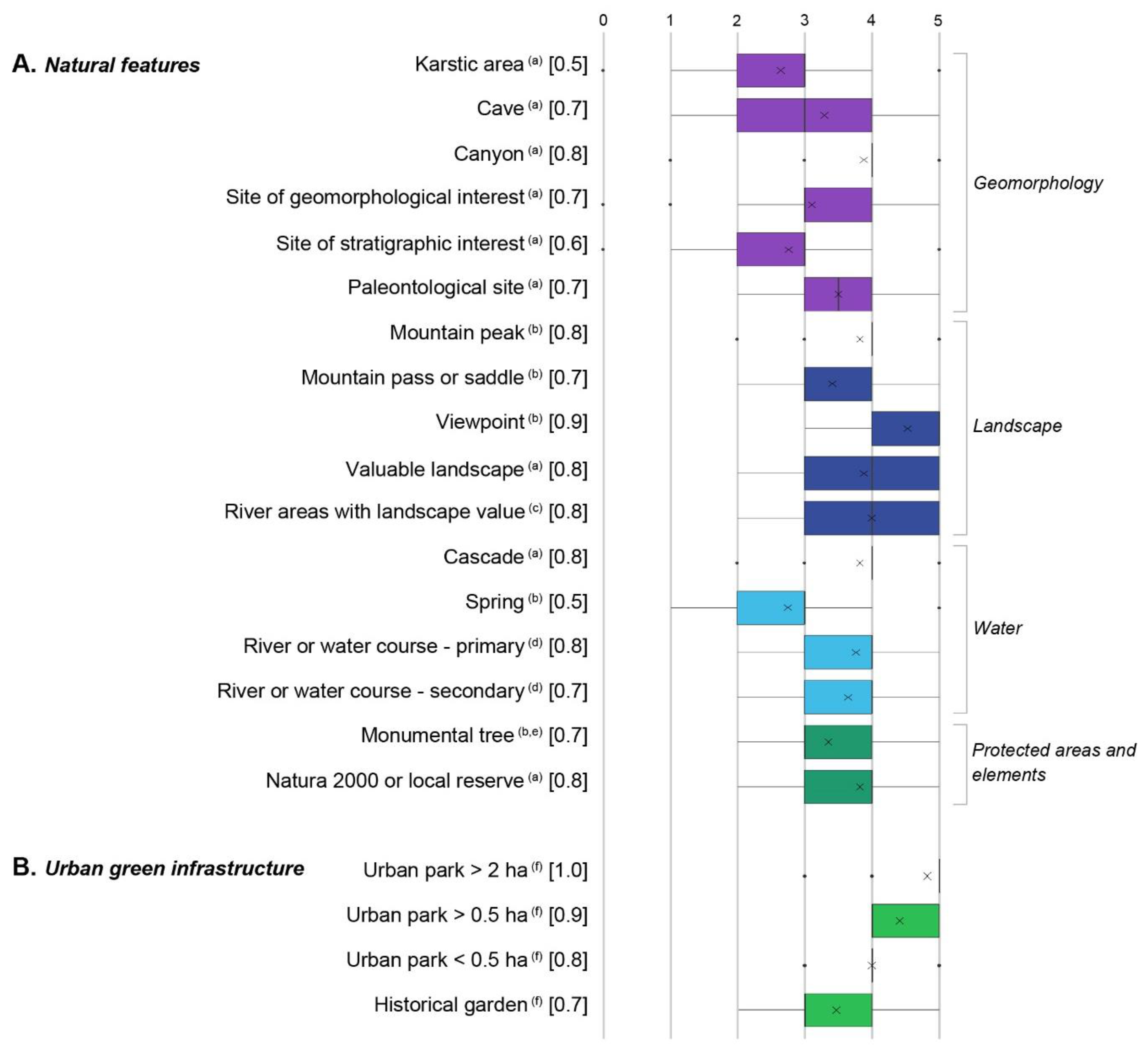
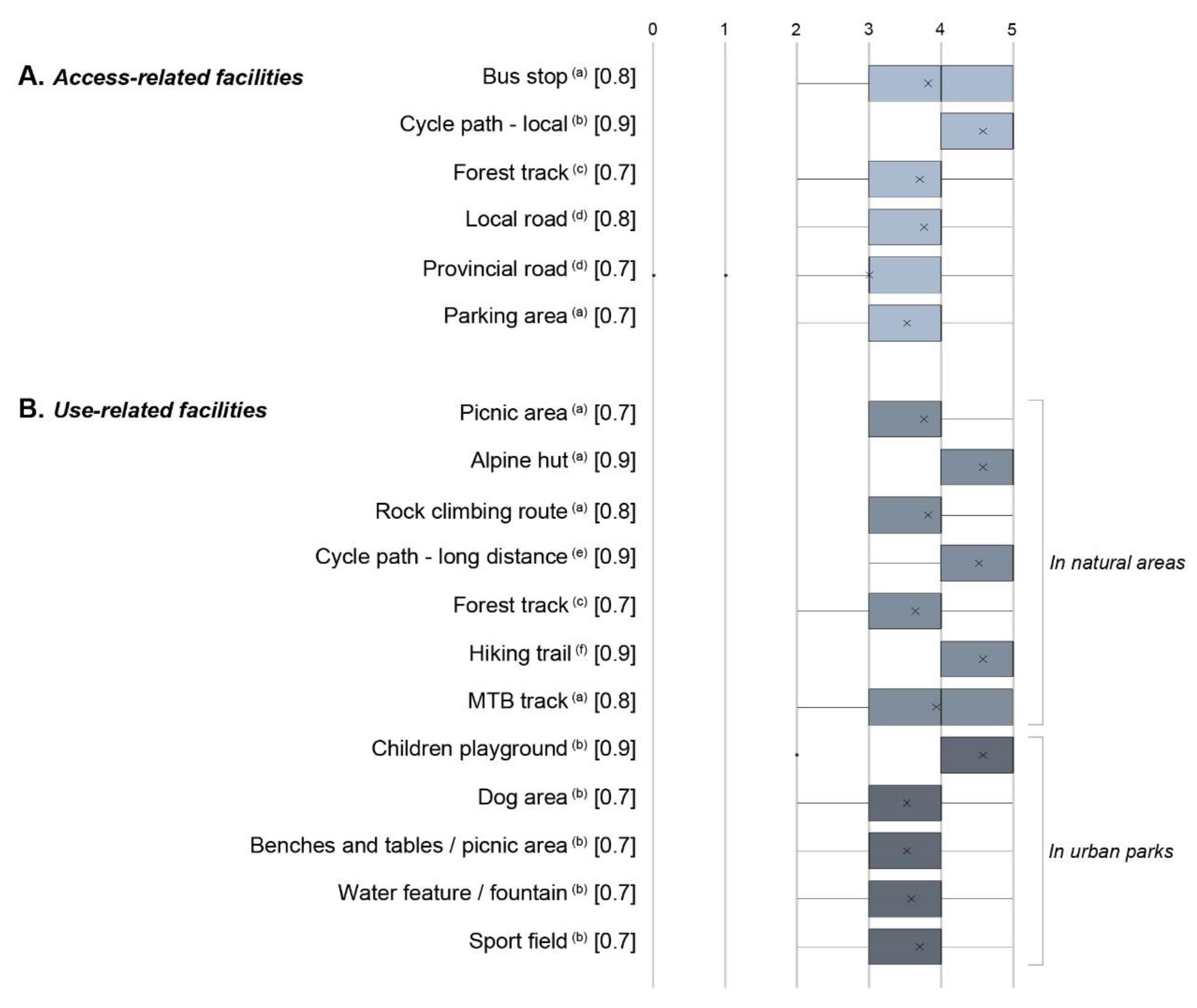
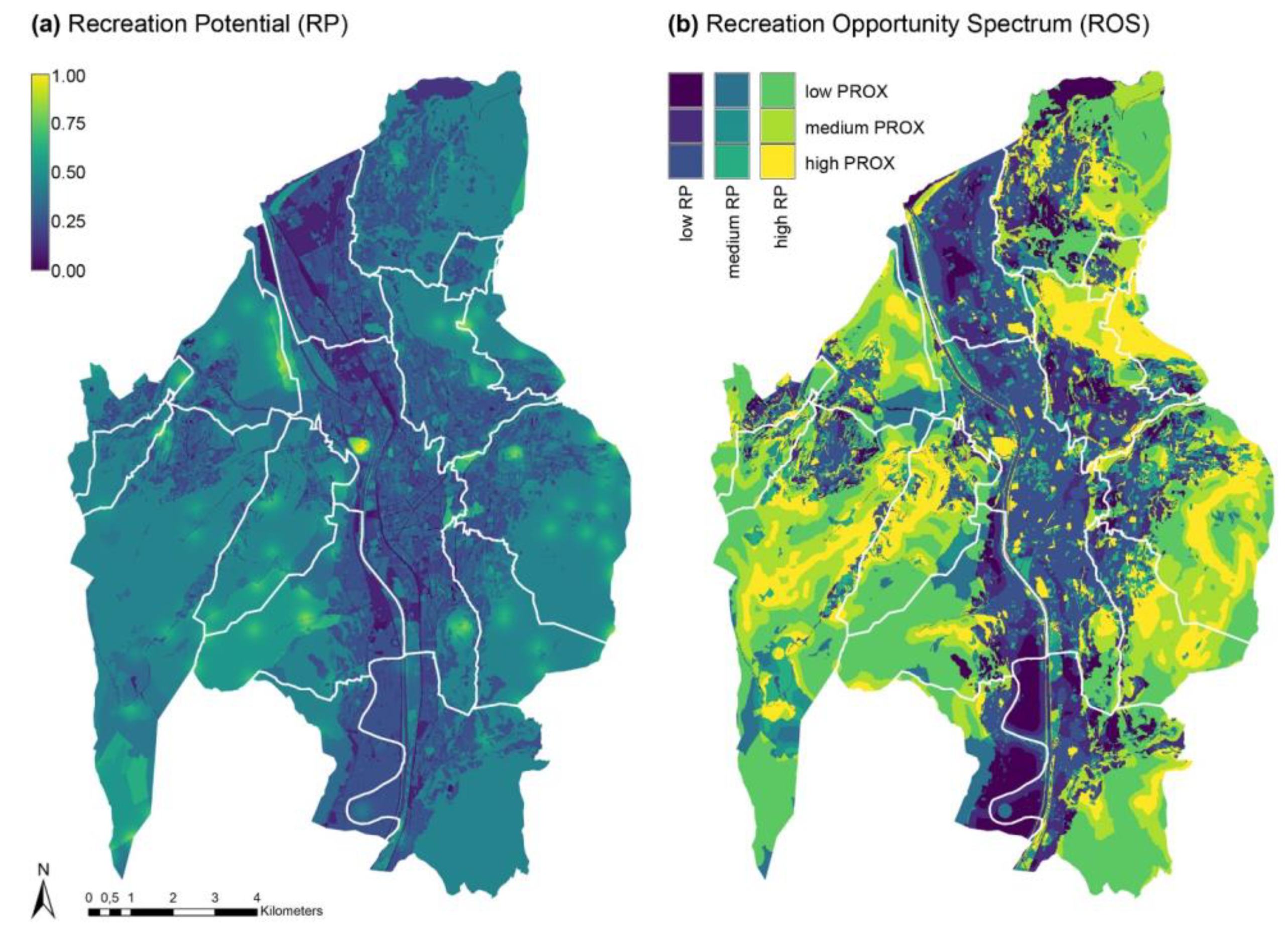
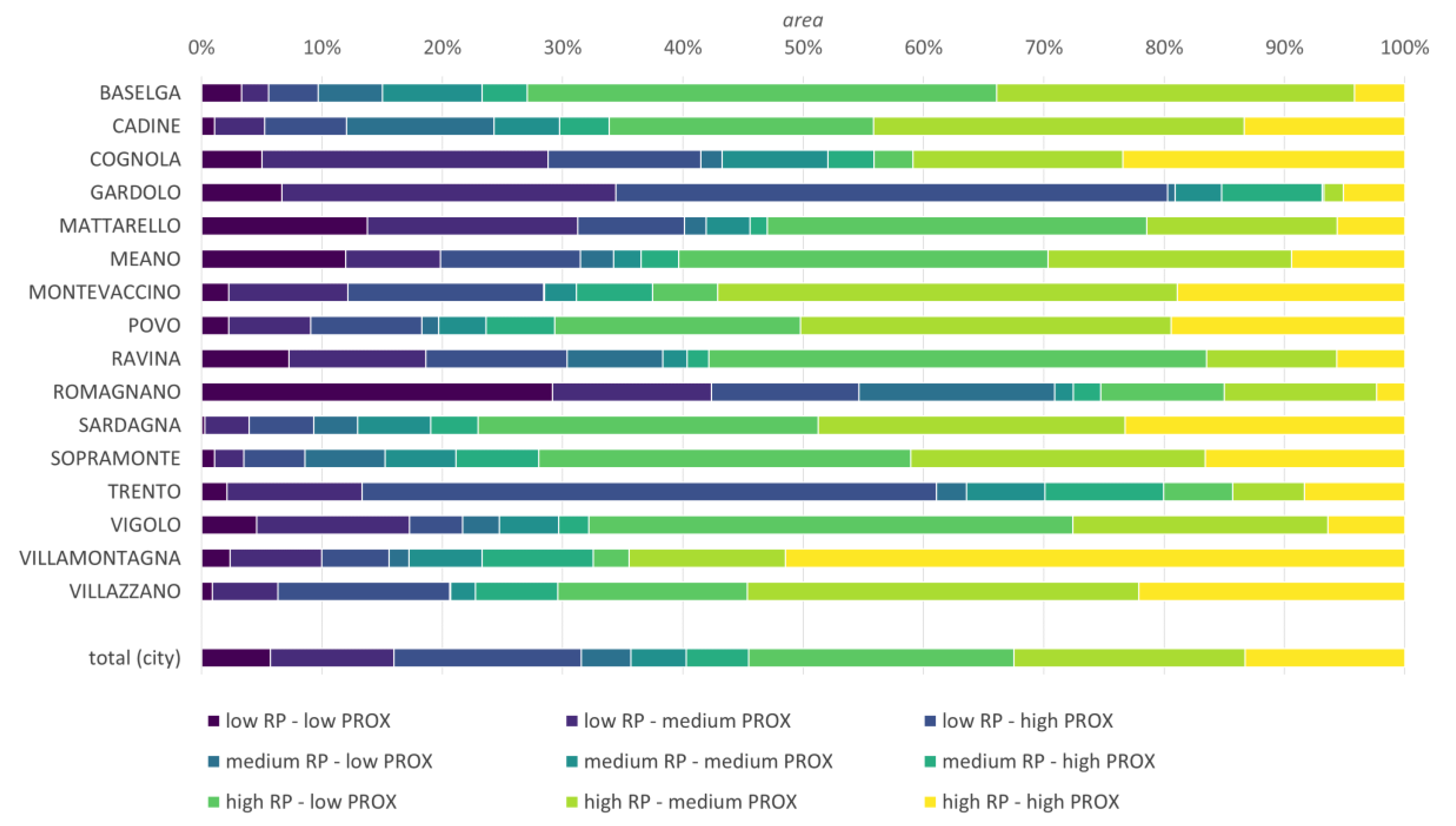
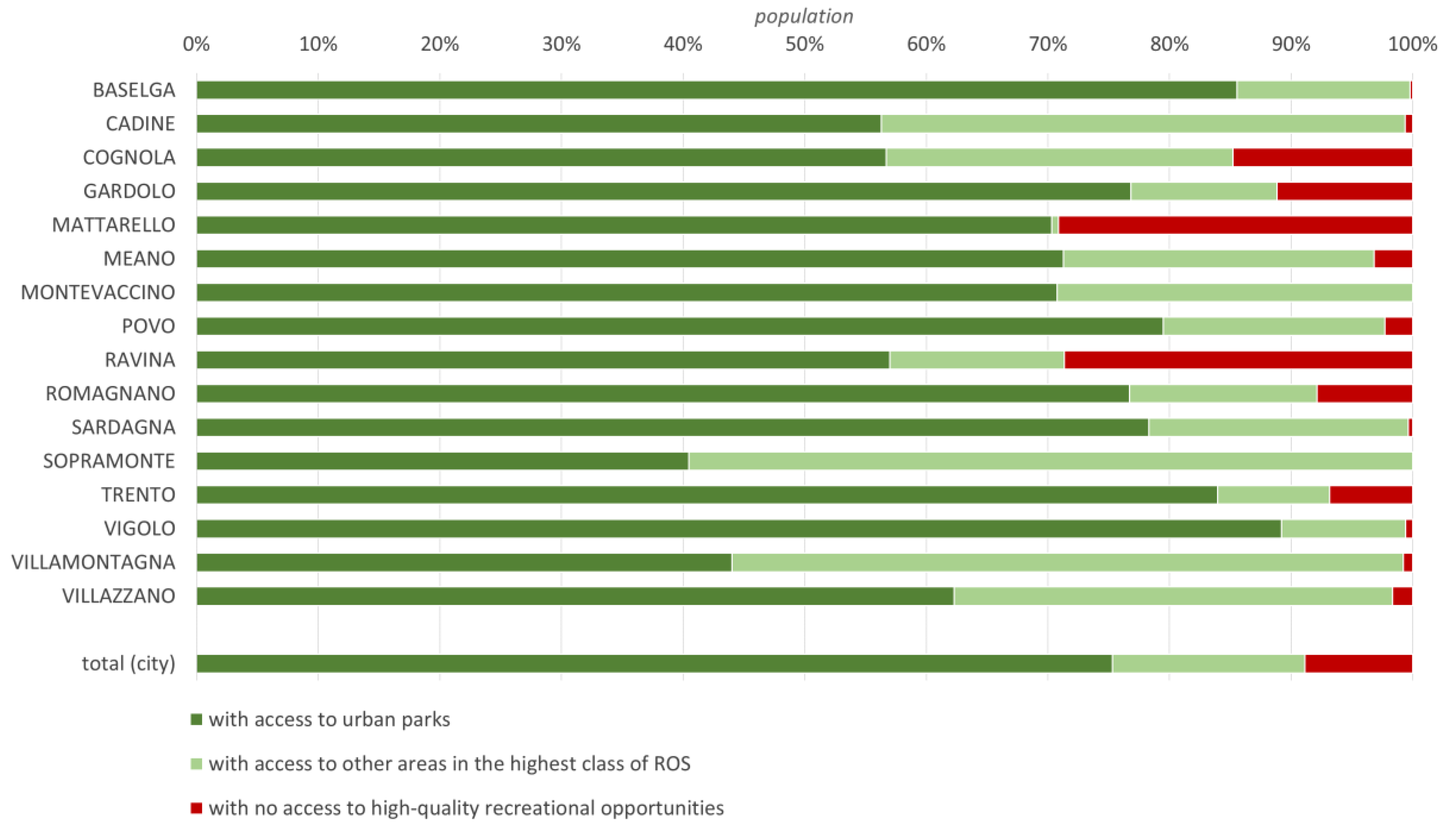
| District | District Area [ha] | Urban Parks [m2] | Areas in the Highest Class of ROS [m2] | Population | Per-Capita Area of Urban Parks [m2/person] | Per-Capita Area in the Highest Class of ROS [m2/person] |
|---|---|---|---|---|---|---|
| Baselga | 246.67 | 11,017 | 103,602 | 491 | 22.4 | 211.0 |
| Cadine | 727.47 | 5554 | 971,173 | 1549 | 3.6 | 627.0 |
| Cognola | 862.44 | 78,869 | 2,022,433 | 10,748 | 7.3 | 188.2 |
| Gardolo | 881.80 | 141,625 | 451,480 | 14,714 | 9.6 | 30.7 |
| Mattarello | 1640.96 | 35,083 | 920,576 | 6156 | 5.7 | 149.5 |
| Meano | 1571.93 | 13,703 | 1,477,611 | 5070 | 2.7 | 291.4 |
| Montevaccino | 154.10 | 1720 | 291,564 | 499 | 3.4 | 584.3 |
| Povo | 1542.57 | 38,335 | 2,997,208 | 5764 | 6.7 | 520.0 |
| Ravina | 1138.51 | 10,456 | 643,260 | 3366 | 3.1 | 191.1 |
| Romagnano | 530.27 | 1756 | 124,082 | 1653 | 1.1 | 75.1 |
| Sardagna | 866.33 | 15,016 | 2,014,200 | 1092 | 13.8 | 1844.5 |
| Sopramonte | 2414.17 | 45,333 | 4,002,694 | 2891 | 15.7 | 1384.5 |
| Trento | 1863.53 | 471,375 | 1,552,321 | 56,362 | 8.4 | 27.5 |
| Vigolo | 306.64 | 986 | 196,252 | 334 | 3.0 | 587.6 |
| Villamontagna | 302.68 | 2111 | 1,558,512 | 1263 | 1.7 | 1234.0 |
| Villazzano | 734.28 | 63,251 | 1,622,761 | 5042 | 12.5 | 321.8 |
| Total (city) | 15,784.34 | 936,191 | 20,949,729 | 116,994 | 8.0 | 179.1 |
© 2018 by the authors. Licensee MDPI, Basel, Switzerland. This article is an open access article distributed under the terms and conditions of the Creative Commons Attribution (CC BY) license (http://creativecommons.org/licenses/by/4.0/).
Share and Cite
Cortinovis, C.; Zulian, G.; Geneletti, D. Assessing Nature-Based Recreation to Support Urban Green Infrastructure Planning in Trento (Italy). Land 2018, 7, 112. https://doi.org/10.3390/land7040112
Cortinovis C, Zulian G, Geneletti D. Assessing Nature-Based Recreation to Support Urban Green Infrastructure Planning in Trento (Italy). Land. 2018; 7(4):112. https://doi.org/10.3390/land7040112
Chicago/Turabian StyleCortinovis, Chiara, Grazia Zulian, and Davide Geneletti. 2018. "Assessing Nature-Based Recreation to Support Urban Green Infrastructure Planning in Trento (Italy)" Land 7, no. 4: 112. https://doi.org/10.3390/land7040112






